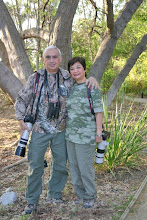And indeed, what's in a name?
This seemingly innocent query came to the forefront in a recent discussion I had with some friends in Facebook. Naturally it was about birds. The point of contention had been what would be the English name of a Bulbul found nowhere else in the Philippines except in the island of Palawan. We all agreed on the scientific name: Alophoixus frater (Although even this evolved from Criniger bres).
The English name though was another matter. Consider these:
Avibase, the world bird database in the internet calls this species Palawan Bulbul (but they retained the Genus Criniger). Their database's last update was Aug. 14, 2012.
Clements, 6th edition version 6.6 dated 2011 gives it the name Gray-throated Bulbul
Howard and Moore, 3rd edition, still calls it Grey-cheeked Bulbul and considers the Palawan bird a subspecies (Criniger bres frater)
The Handbook of the Birds of the World also considers it a subspecies of Grey-cheeked Bulbul but updated the Genus (Alophoixus bres frater)
Finally, the IOC - International Ornithological Congress World Bird List, in its version 3:1 dated April 2012, calls it Palawan Bulbul (Alophoixus frater).
Now which one of these is correct? What name shall I call this bird? If I were to be really controversial about this, I'd call it any name I want...for who would question me when even the renowned scientists cannot even agree on one single appellation for this poor creature.
May I then posit the following alternative: Brother's Bulbul.
After all the species name frater, which all scientists agree on, means brother.
Sometimes I am perplexed as to how people arrive at the English names of birds. I once emailed worldbirdnames.org, reputedly the final authority when it comes to establishing the English names of all the birds of the world. I asked them if there had been an unintended switch on the names of the Laughing Gull and the Black-headed Gull. My point was based on the scientific names of both seabirds. Laughing Gull is known as Larus atricilla while the Black-headed Gull is Chroicocephalus ridibundus. I found it strange that ridibundus which is translated as "laughing" was given an English name Black-headed, whereas atricilla which means "black-eyebrowed" was dubbed as Laughing Gull!
The explanation I received was, I must admit, rather disappointing:
"Interesting. Certainly not a recent mistake. If so, it goes a long way back in history."
It was signed by Frank Gill, the man behind the IOC's efforts to standardize the English names to be used on every single one of the world's birds.
Again, let's go back to the original question: What's in a name?
For now I am following the IOC list (and therefore calling the bird in question Palawan Bulbul).
Even if they would not (could not?) change what was an apparent mistake in the historical nomenclature regarding the gulls mentioned earlier, I very much appreciate their ongoing efforts to establish a norm for naming birds in English. They are also one of the most up-to-date among the internet bird lists. Their guiding principle says it all:
"Wisdom begins with putting the right name on a thing." - Old Chinese Proverb.

.jpg)


1 comment:
Great photo. Thanks for all your great birdwatching adventures you share.
Lee's Birdwatching Adv.
Post a Comment